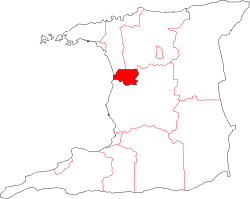Chaguanas
| Chaguanas | |
|---|---|
| City-Borough | |

Chaguanas Main Road
|
|
 |
|
| Coordinates: 10°30′N 61°23′W / 10.500°N 61.383°WCoordinates: 10°30′N 61°23′W / 10.500°N 61.383°W | |
| Country | Trinidad and Tobago |
| Jurisdiction | Borough of Chaguanas |
| Incorporated | 1990 as Borough |
| Government | |
| • Mayor | Gopaul Boodhan |
| • Governing body | Chaguanas Borough Corporation |
| Area | |
| • City-Borough | 59.65 km2 (23.03 sq mi) |
| • Urban | 59 km2 (23 sq mi) |
| Population (2011) | |
| • City-Borough | 83,516 |
| • Density | 1,416/km2 (3,670/sq mi) |
| Ranked 3rd | |
| Time zone | AST (UTC-4) |
| Area code(s) | 868 |
The Borough of Chaguanas is the largest borough (83,516 at the 2011 census) and fastest-growingtown in Trinidad and Tobago. Located in Central Trinidad about 18 km (11 mi) south of Port of Spain, it originally grew in size due to its proximity to the Woodford Lodge sugar refinery and the Central Trinidad town of Couva. It remained a minor town until the 1980s when it began to grow rapidly as it drew people for its bargain shopping and moderately-priced housing. However, its rapid growth has seen property values increase dramatically.
Chaguanas became a borough in 1990; prior to that it was part of the County of Caroni. The current mayor is His Worship Gopaul Boodhan and the Borough Council has historically been dominated by the United National Congress.
Chaguanas was named for the Chaguanes Amerindian tribe. The area was settled by the time of the British conquest of Trinidad in 1797 (see History of Trinidad and Tobago). The town originated on what was then H.E. Robinson's sugar estate adjacent to the Woodford Lodge sugar refinery and the De Verteuil coconut and cocoa estate to the north and east. It was sold over to the now defunct Caroni (1975) Ltd when sugar was the main export commodity for Trinidad and Tobago, and was part of the Woodford Lodge Estate that is home to several buildings including the homes of several ex-Caroni workers.Construction of the Trinidad Government Railway helped the town grow.
The Princess Margaret Highway, built by the US military during World War II, joined the Southern Main Road at Chaguanas. Construction of the Sir Solomon Hochoy Highway extended the highway south to San Fernando. The Carlsen Air Force Base was a former United States Army Air Forces World War II airbase constructed in Carlsen Field in 1942, consisting of two landing strips, "Edinburgh" and "Xeres". The airbase also included an emergency landing strip, "Tobago". Edinburgh Field became the principal combat base for USAAF bombers and Naval airships on Trinidad as well as Navy fighters with a complex of runways and taxiways that surpassed even Waller Field. This lasted until 3 November 1943 when, it was renamed Carlsen Field. It was also used by the Royal Air Force and was defended by US Army infantry and AA units. When the Navy began lighter-than-air operations in the Caribbean in the fall of 1943, the 80th Seabees were brought in to build a station at Carlsen Field. To supplement the eight Army-owned buildings taken over by the Navy, the 80th Battalion built a large, steel blimp hangar, a mooring circle, paved runways, a helium-purification plant, and other operational appurtenances. The facility was formally disestablished on 1950, and today the former air and naval airship base has been turned into a dairy and agricultural area south of Chaguanas and is all but unrecognizable. Much of the former airfield area is owned by National Flour Mills (NFM) and the only remnants of the base are the name of the area in south Chaguanas, along with streets named "Edinburgh" and "Xeres".
...
Wikipedia
